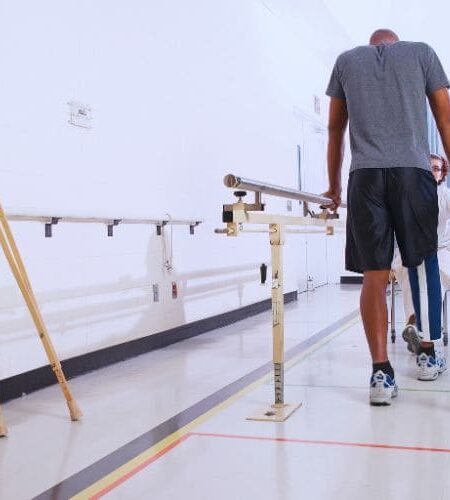Rehabilitation exercises for single crutch users can vary based on the specific needs and limitations of the individual. It’s important to note that these exercises should be performed under the guidance of a healthcare professional or physical therapist. The following are general exercises that may be included in a rehabilitation program for single crutch users:
- Weight Shifting:
- Stand with your feet shoulder-width apart.
- Shift your weight onto the crutch side while keeping the injured or weaker leg off the ground.
- Hold for a few seconds and then shift the weight back to the other side.
- Repeat the process, gradually increasing the duration of each hold.
- Single Leg Balance:
- Hold onto a stable surface for support.
- Lift the unaffected leg off the ground and balance on the injured or weaker leg.
- Focus on maintaining good posture and stability.
- Hold for as long as you can, gradually increasing the duration.
- Heel Raises:
- Stand with your feet hip-width apart, holding onto a support for balance.
- Lift your heels off the ground, rising onto your toes.
- Slowly lower your heels back down.
- Perform 2-3 sets of 10-15 repetitions.
- Toe Taps:
- Sit on a sturdy chair with the injured leg extended in front.
- Gently tap your toes on the floor and then lift the foot.
- Repeat the motion, focusing on controlled movements.
- Perform 2-3 sets of 10-15 repetitions.
- Seated Marching:
- Sit on a chair with good posture.
- Lift the injured or weaker leg, as if you are marching in place.
- Focus on controlled movements and engaging the muscles.
- Perform 2-3 sets of 10-15 repetitions.
- Partial Squats:
- Stand with your feet shoulder-width apart, holding onto a support.
- Lower your body into a partial squat, bending at the hips and knees.
- Keep the weight on your heels and maintain good posture.
- Perform 2-3 sets of 10-15 repetitions.
- Step-Ups:
- Use a sturdy step or platform.
- Step up onto the platform with the injured leg, then step back down.
- Ensure controlled movements and proper balance.
- Perform 2-3 sets of 10-15 repetitions.
Always consult with a healthcare professional or physical therapist before starting any rehabilitation exercises, as they can provide personalized guidance based on your specific condition and needs
FAQs:
- Why are rehabilitation exercises important for single crutch users?
- Rehabilitation exercises help improve strength, balance, and mobility, facilitating the recovery process after an injury or surgery. They also promote a faster return to normal activities.
- Can I perform these exercises on my own, or do I need supervision?
- While these exercises are generally safe, it’s recommended to perform them under the guidance of a healthcare professional or physical therapist to ensure they are appropriate for your specific condition and to prevent any potential issues.
- How often should I do these exercises?
- The frequency of exercises depends on your individual rehabilitation plan. Typically, you might be advised to perform these exercises daily or as recommended by your healthcare provider.
- Are there any warning signs or symptoms to watch out for during exercises?
- If you experience increased pain, swelling, or any unusual discomfort during or after exercises, stop immediately and consult your healthcare provider. It’s important to listen to your body and not push beyond your limits.
- Can I combine these exercises with other forms of physical activity?
- Depending on your condition, your healthcare provider may recommend additional activities. It’s essential to follow their advice to avoid any potential complications or setbacks in your recovery.
- How long does the rehabilitation process typically take?
- The duration of rehabilitation varies based on the type and severity of the injury. Your healthcare provider can give you a better estimate based on your specific case.
- Can I use these exercises for any type of leg injury or surgery?
- These exercises are general in nature. Specific exercises may need to be modified or excluded based on the nature of your injury or surgery. Consult with your healthcare provider for exercises tailored to your condition.
- Are there any lifestyle changes or precautions I should take during rehabilitation?
- Your healthcare provider may provide specific guidelines for daily activities, use of crutches, and precautions to ensure a safe and effective rehabilitation process.
